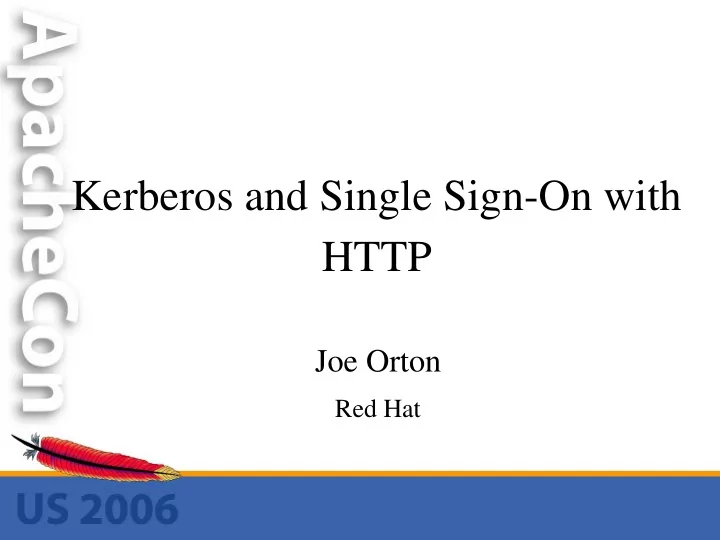

Kerberos and Single Sign-On with HTTP Joe Orton Red Hat
Overview • Introduction • The Problem • Current Solutions • Future Solutions • Conclusion
Introduction • WebDAV: common complaint of poor support for authentication in HTTP • Kerberos is “the” network authentication protocol
The Problem • How to integrate HTTP servers into a Kerberos infrastructure? • Single Sign-On: reducing the number of times people enter passwords • Ideal: user authentication happens exactly once per “session”
Session Scope • Never have to authenticate to any individual server • Never have to authenticate to use any particular service (protocol)
Problem Scope • Covering intranet/enterprise/organisation- wide HTTP authentication • Out of scope: SSO for “The Web” • In scope? Proxy authentication
One-Slide-Guide to Kerberos • Shared secret keys, a trusted third-party (KDC), and symmetric key encryption • KDC authenticates user, gives out “TGT” • Using TGT, client obtains “ticket” from KDC encrypted with service's secret key • Client can prove user identity to a service
Why is this so difficult? • Traditional Internet protocols (e.g. SMTP, IMAP, ...) all support Kerberos authentication • Why is HTTP different?
Authentication and Security • Strong authentication is not much use without message integrity, and probably also confidentiality • Integrity/confidentiality = transport layer • HTTP authentication is independent of the transport layer; unlike SMTP, POP3, ...
Current Solutions • Stanford WebAuth: forms and cookies • HTTP “Basic” authentication • HTTP “Negotiate” authentication
Stanford WebAuth • Based on forms+cookie • Token-passing via browser redirects between web server and “WebKDC” • Kerberos credentials passed to WebKDC via HTML form • WebKDC authenticates as user to KDC
WebAuth protocol User Agent GET /private Web Server 302 Redirect User Agent Location: http://webkdc.example.com/...
WebAuth protocol 2 User Agent GET /authenticate-me WebKDC 200 OK + HTML form User Agent
WebAuth protocol 3 User Agent POST /authenticate-me WebKDC WebKDC KDC 302 Redirect User Agent Location: http://origin.example.com/private Set-Cookie: blah
WebAuth analysis • “Application level” solution • Cookies + HTML != HTTP authentication • Requires a real web browser: won't work with generic WebDAV clients • Requires SSL for submitting credentials, for maintaining secure sessions
WebAuth analysis 2 • Training users to enter Kerberos credentials into web forms is Very Bad ™ - phishing • Session scope: within one web browser but then covers all servers • Cannot authenticate to proxies • Session termination? Flush cookies
Kerberos via Basic Auth • Use standard HTTP Basic authentication • Client sends Kerberos credentials as normal Basic auth credentials • Web server authenticates as user directly to KDC; custom server extension needed e.g. mod_auth_kerb •
Kerberos via Basic, on the wire GET /secret/ HTTP/1.1 HTTP/1.1 401 Unauthorized WWW-Authenticate: Basic realm=”Blah” GET /secret/ HTTP/1.1 Authorization: Basic QWxuIHNlc2FZQ== HTTP/1.1 200 OK
Kerberos via Basic, analysis • Simple to set up • Works with any HTTP client (e.g. DAV) • Requires SSL for entire session • Can authenticate to proxies, but insecurely – cleartext only to proxy
Kerberos via Basic, analysis 2 • Session scope: one web browser, one server • Training users to enter credentials into HTTP authentication dialogs is also Very Bad ™ • Session termination: flush cached credentials
The “Negotiate” Scheme • New HTTP authentication scheme (kind of) • Written by Microsoft; I-D published 2001 • Became “Informational” RFC 4559 in 2006 • Uses GSSAPI token exchange, wraps Kerberos protocol over the wire • Custom server, client extension
Negotiate: Protocol trace 1. GET /secret/ HTTP/1.1 2. HTTP/1.1 401 Unauthorized WWW-Authenticate: Negotiate [token] 3. GET /secret/ HTTP/1.1 Authorization: Negotiate Y.....Q== [goto 2, or...] HTTP/1.1 200 OK
Implementing Negotiate • Supported at HTTP protocol level; works with WebDAV etc • Implemented by Firefox, MSIE • Requires SSL to secure the connection • Could almost work with proxies
Negotiate analysis • Even the name is bad • Per-connection authentication! • Breaks RFC2617 challenge grammar • Abuses RFC2617 headers
Negotiate analysis 2 • Real Single Sign-On! • Session scoped to all servers, all services • Session termination dictated by system-wide Kerberos session
mod_auth_kerb • Module for Apache httpd 1.3/2.x • Maintained by Daniel Kouril, BSDy license • Version 5.0 released August 2006, first non- beta release • Supports both Negotiate and Kerberos-over- Basic authentication
mod_auth_kerb Configuration • Obtain a service key from the KDC • Name, for example: HTTP/www.example.com@EXAMPLE.COM • Service key in keytab – check permissions! • Load module and add access control configuration, either httpd.conf or .htaccess
Access control Configuration <Location /private> AuthType Kerberos AuthName "Kerberos Login" KrbMethodNegotiate On KrbMethodK5Passwd Off ...
Access control continued KrbAuthRealms EXAMPLE.COM Krb5KeyTab /etc/httpd/conf/keytab require valid-user SSLRequireSSL </Location>
Client configuration • Firefox: • MSIE should work within “Intranet zone”
Conclusion • Strong authentication as an HTTP authentication scheme alone is not enough • “Negotiate” is a practical if flawed solution for Kerberos Single Sign-On with HTTP • But must be used over SSL
Future Solutions • A better Negotiate • RFC2712: TLS with Kerberos ciphersuites • Implemented in OpenSSL; no deployment • A “GSSAPI Transport Layer” for HTTP? • Implement via Upgrade: header (RFC2817)
Resources • http://webauth.stanford.edu/ • http://modauthkerb.sourceforge.net/ • http://www.ietf.org/rfc/rfc4559.txt • http://www.ietf.org/rfc/rfc2712.txt • These slides: http://people.apache.org/~jorton/ac06us/
Q&A Any questions?
Recommend
More recommend